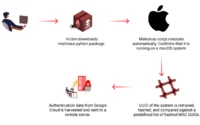The Importance of Continuous Penetration Testing: What You Need to Know

Continuous Attack Surface Penetration Testing (CASPT): An Overview
Continuous Attack Surface Penetration Testing (CASPT) is a proactive security practice that focuses on the ongoing and automated penetration testing of an organization’s digital assets. This approach is essential for enterprises with constantly evolving attack surfaces, where traditional, periodic penetration tests are insufficient. Unlike the conventional method, which is typically performed annually or semi-annually, CASPT is a continuous process integrated directly into the software development lifecycle (SDLC), ensuring vulnerabilities are identified and addressed in real-time.
CASPT is designed to stay ahead of potential threats by continuously assessing the security posture of an organization. It helps security teams identify critical entry points that could be exploited by attackers, validate the effectiveness of existing security measures, and ensure that new code or infrastructure changes do not introduce new vulnerabilities. Organizations can run baseline tests to track changes or updates across assets, creating a roadmap for penetration testing teams as soon as new vulnerabilities are detected.
What CASPT Is Not
While CASPT shares similarities with traditional penetration testing, there are key differences:
- Not a One-Time Assessment: Traditional penetration testing is typically conducted once a year or semi-annually. CASPT, on the other hand, is an ongoing process that involves continuous or frequent scheduled tests.
- Not Solely Automated: CASPT is not limited to automated tools. Although automation plays a significant role, human expertise is also required to perform more sophisticated, context-aware attacks that automated tools might miss.
- Not Isolated: CASPT is not a standalone practice. It is integrated with other security measures, such as Attack Surface Management (ASM) and Red Teaming exercises, to provide a comprehensive view of an organization’s security posture.
Application of CASPT Across Different Digital Assets
CASPT can be applied to various digital assets, including:
- Web Applications: Continuous testing helps identify vulnerabilities like SQL injection, cross-site scripting (XSS), and broken authentication mechanisms. Automated tools can scan for known vulnerabilities, while manual testing can uncover more complex logic flaws.
- APIs: With the increasing prevalence of APIs, they present a growing attack surface. API Penetration Testing ensures APIs are secure against common threats such as API key leaks and injection attacks.
- Cloud Environments: As organizations move to cloud-based infrastructure, cloud security becomes crucial. Continuous penetration testing in the cloud checks configurations, access controls, and potential vulnerabilities to prevent unauthorized access and data breaches.
- Networks: Network security is fundamental to an organization’s security posture. Continuous penetration testing of networks involves scanning for open ports, misconfigured firewalls, and outdated software that could be exploited by attackers.
- Mobile Applications: Securing mobile apps is essential due to their widespread use. Continuous penetration testing for mobile apps focuses on vulnerabilities specific to mobile environments, such as insecure data storage and weak encryption.
Integration with Attack Surface Management and Red Teaming
Integrating CASPT with Attack Surface Management (ASM) and Red Teaming offers a robust security approach that enhances an organization’s resilience against cyber threats:
- Continuous Attack Surface Penetration Testing (CASPT): This involves ongoing, automated assessments to identify vulnerabilities, ensuring security evaluations are always current.
- Attack Surface Management (ASM): ASM continuously monitors and analyzes an organization’s digital footprint, helping to prioritize which assets need immediate testing.
- Red Teaming: This involves ethical hackers simulating real-world cyberattacks. When combined with CASPT, red teams can focus on the most critical and vulnerable areas, increasing the likelihood of uncovering sophisticated attack vectors.
The Importance of CASPT
CASPT offers several key benefits:
- Cost-Effectiveness: Although the initial investment in CASPT may be higher, the long-term cost savings are significant. Continuous identification and mitigation of vulnerabilities help organizations avoid costs associated with data breaches, regulatory fines, and reputational damage.
- Increased Visibility: CASPT provides ongoing visibility into an organization’s security posture, allowing vulnerabilities to be addressed as they arise rather than waiting for the next scheduled test.
- Compliance: CASPT helps organizations meet regulatory requirements by providing continuous security testing data that can be used to demonstrate compliance.
- Attack Path Validation and Mapping: Advanced CASPT providers offer continuous validation of attack paths, providing automatic visualization that maps out all potential routes an attacker might take to compromise critical assets.
Why Annual Penetration Testing Is No Longer Enough
The cybersecurity landscape is constantly evolving, with new threats and vulnerabilities emerging daily. Annual penetration testing, while valuable, is no longer sufficient to keep up with these changes due to:
- Delayed Identification of Vulnerabilities: Annual testing may leave vulnerabilities undiscovered for months, whereas CASPT ensures vulnerabilities are identified and addressed as soon as they are introduced.
- Dynamic Environments: Modern IT environments are highly dynamic, with frequent changes to code, infrastructure, and configurations. CASPT accounts for these continuous changes, ensuring critical vulnerabilities are not missed.
- Increased Attack Sophistication: Attackers are becoming more sophisticated, employing advanced techniques to bypass traditional defenses. Continuous testing helps organizations stay ahead of these evolving threats.
Top 10 Use Cases for CASPT
CASPT is particularly beneficial for organizations with:
- Highly Dynamic Environments: Ensures security assessments keep pace with frequent changes.
- Regulatory and Compliance Requirements: Helps meet stringent security standards.
- High-Value Targets: Provides an essential layer of defense for organizations more likely to be targeted.
- Mature Security Programs: Complements existing security measures for organizations looking to adopt a proactive security posture.
- Cloud-Native or Hybrid Environments: Ensures security assessments are as agile as the infrastructure.
- Increased DevSecOps Practices: Integrates seamlessly into the CI/CD pipeline, identifying vulnerabilities early in the SDLC.
- Mergers & Acquisitions: Quickly identifies vulnerabilities in newly acquired assets.
- Third-Party Risk Management: Regularly assesses third-party systems and integrations to prevent them from becoming attack vectors.
- Alignment with DevSecOps: Embeds security into the development process.
- Enhanced Incident Response: Provides invaluable data for incident response teams.
When Not to Consider CASPT
Smaller organizations with limited security budgets or relatively static IT environments may find CASPT challenging to implement. In such cases, periodic pentesting combined with regular security audits might be sufficient.
Best Practices for Implementing CASPT
- Determine Frequency: Base the frequency of CASPT on the organization’s risk profile and the criticality of assets.
- Set Clear Objectives: Define clear objectives for the testing process.
- Establish Clear Communication Channels: Ensure effective communication between security teams and other stakeholders.
- Use Both Manual and Automated Testing: Combine automation with manual testing to uncover complex issues.
Conclusion
CASPT represents a significant shift in how organizations approach security. By adopting a continuous, proactive approach to penetration testing, organizations can stay ahead of emerging threats, improve their security posture, and protect their most valuable assets. While the initial investment may be higher, the long-term benefits—such as cost savings, increased visibility, and enhanced compliance—make CASPT a critical component of any modern security strategy.
In summary, CASPT is not just a security measure—it’s a strategic advantage. Organizations that embrace CASPT can expect to achieve greater resilience by taking the fight to the attackers, staying ahead in the cybersecurity game.



